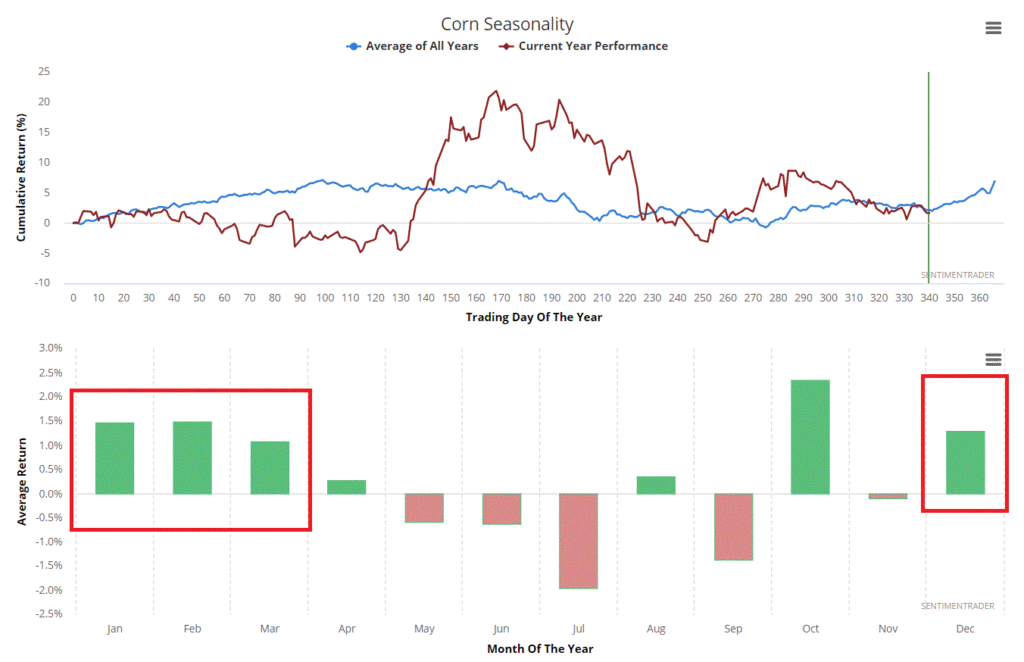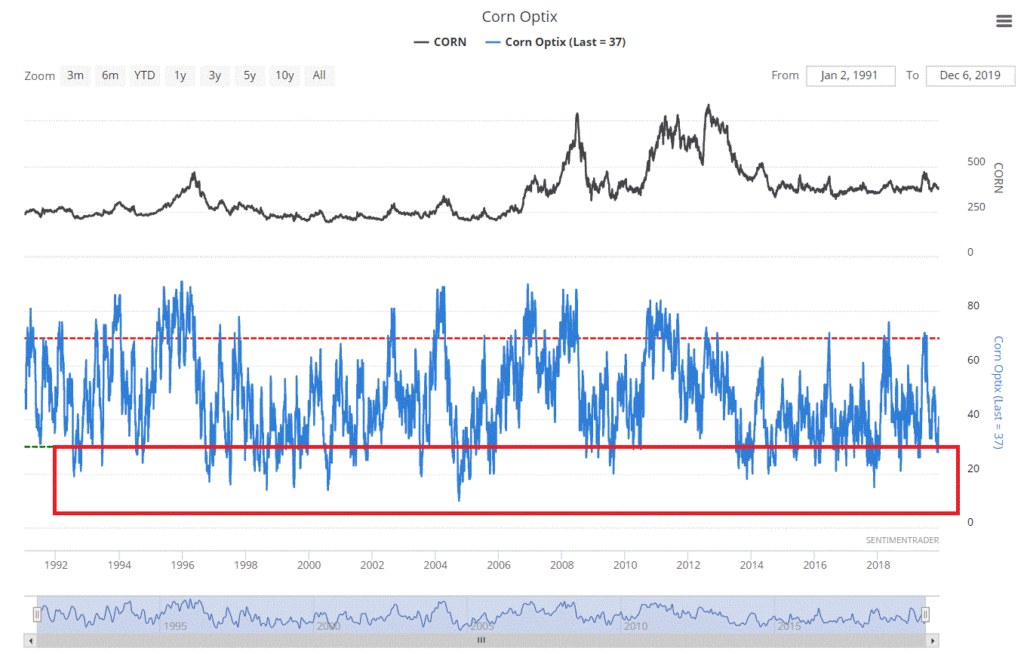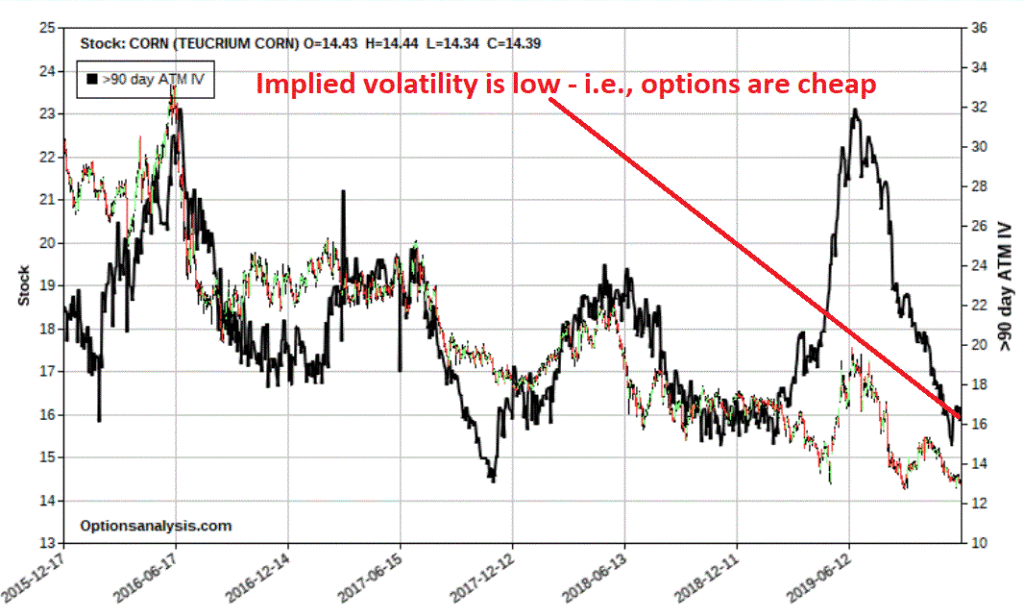In a recent article I wrote about a potential seasonal speculation in soybeans. A similar potential opportunity also exists in the corn market. Like beans, the corn market is a highly cyclical market. This is in large part due to the planting and growing season (as explained here). This article is about a “seasonal/cyclical” speculative play using options on ticker CORN.
There are two key caveats:
*The trade highlighted is NOT a “recommendation”, only an example of how to speculate on a potential move using options in order to achieve limited risk and unlimited profit potential.
*Options on ticker CORN are very thinly traded. So, any investor who might choose to wade in needs to be aware that they may need to consider using a limit order in order to avoid significant slippage.
The Setup
Figure 1 displays the annual seasonal trend for corn according to www.sentimentrader.com.

Figure 1 – Annual seasonal trend for Corn (Courtesy: www.sentimentrader.com)
It is critical to understand that this is the “average” for what has happened in the past and should in no way be viewed as a “roadmap”. Still, the point is pretty clear – late in the year through the month of April tends to be the “bullish” time for corn.
Figure 2 displays that bullish sentiment for corn was recently quite low. While this by no means guarantees a rally, historically this often a signal that downside risk may be relatively low.

Figure 2 – Bullish Sentiment for Corn (Courtesy: www.sentimentrader.com)
Figure 3 tells us that options on the ETF ticker CORN (which tracks the price of corn futures) are presently cheap – i.e., implied option volatility (the black line in Figure 4) is extremely low. This tells us that little option premium is built into the prices of CORN options.

Figure 3 – Ticker CORN with implied option volatility (Courtesy www.OptionsAnalysis.com)
Figures 4 and 5 display the particulars for one possible speculative play designed to make money if CORN does in fact move higher sometime between now and the end of April 2020.

Figure 4 – CORN May2020 calls (Courtesy www.OptionsAnalysis.com)

Figure 5 – CORN May2020 call risk curves (Courtesy www.OptionsAnalysis.com)
So, is this really a good idea? I am not actually saying that it is. As always with this blog, this is not a “recommendation”, only an “example.” Let’s hit the most important points to consider with this example.
A few things to note:
*This position qualifies as “serious bottom picking” – which is generally considered to be a loser’s bet. However, the mitigating factor here is that we are risking only $90 (or possibly less if a limit order is used to enter) per contract. And position sizing should be kept on the small size. For example, a trader with $25,000 might buy a 3-lot and risk 1.1% of their trading capital.
*If CORN does NOT advance at anytime in the next 5 months this trade is certain to lose money.
*If CORN were to rally to its it’s 2019 high of $17.55 a share, this position would roughly triple in value.
So, the bottom-line questions for a trader in considering this trade are:
*Are you OK with risking $90 per contract on the hopes that corn will rise between now and the end of April 2020?
*If you do enter the trade, how many contracts will you buy/what percentage of your trading capital will you risk?
*If CORN fails to rally will you simply hold the options or will you consider exiting early if – for example – a key support level is broken?
*If CORN does advance at what share price or option trade profit level will you, a) take a profit or b) adjust the trade?
Buying inexpensive call options is something of a siren song for a lot of traders and can lead to mistakes. But sometimes it can make a lot of sense as long as you:
*Put as many factors in your favor
*Don’t bet the ranch
*Formulate and follow a trade plan
Jay Kaeppel
Disclaimer: The information, opinions and ideas expressed herein are for informational and educational purposes only and are based on research conducted and presented solely by the author. The information presented does not represent the views of the author only and does not constitute a complete description of any investment service. In addition, nothing presented herein should be construed as investment advice, as an advertisement or offering of investment advisory services, or as an offer to sell or a solicitation to buy any security. The data presented herein were obtained from various third-party sources. While the data is believed to be reliable, no representation is made as to, and no responsibility, warranty or liability is accepted for the accuracy or completeness of such information. International investments are subject to additional risks such as currency fluctuations, political instability and the potential for illiquid markets. Past performance is no guarantee of future results. There is risk of loss in all trading. Back tested performance does not represent actual performance and should not be interpreted as an indication of such performance. Also, back tested performance results have certain inherent limitations and differs from actual performance because it is achieved with the benefit of hindsight.

